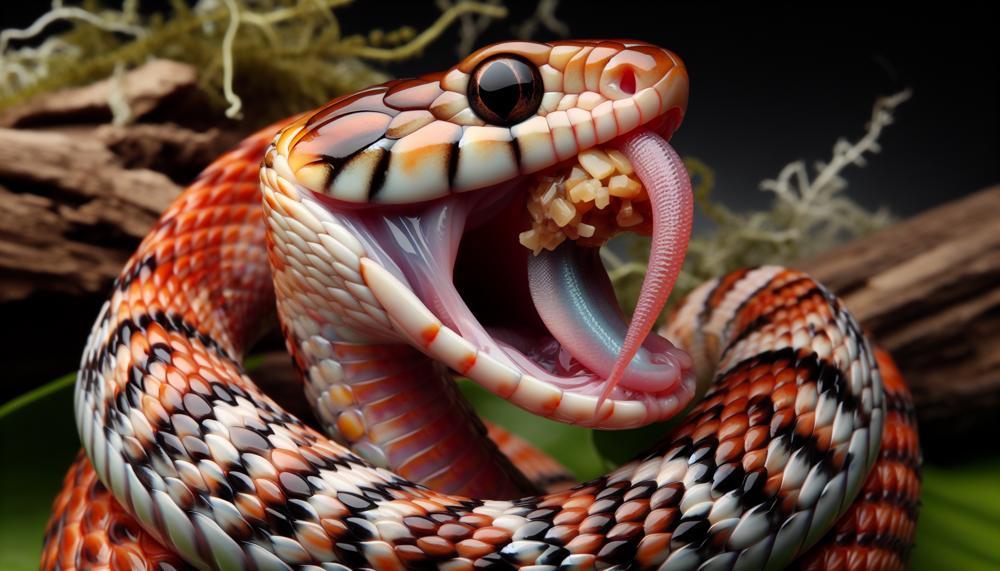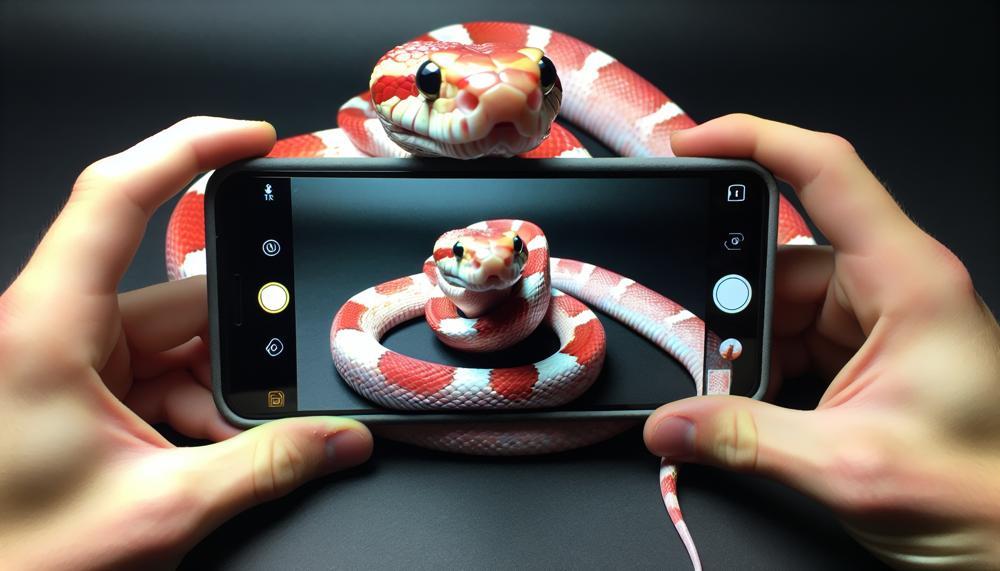Are you the proud caretaker of a majestic corn snake? Do you want to ensure your scaly companion is well-fed and thriving? Today’s blog post is all about a common mistake that many corn snake owners make – overfeeding. Yes, you heard it right – overfeeding. You might be thinking, “But my snake loves to eat.” or “What harm can an extra treat do?”
But let me tell you, there are serious consequences to giving your corn snake too much food. Let’s take a closer look at some key points:
- Corn snakes are opportunistic feeders and will devour as much food as they can.
- Overfeeding can lead to obesity and other health issues in these slithery creatures.
- It can also shorten their lifespan and diminish their overall well-being.
- A proper feeding schedule and portion control are essential for maintaining a healthy weight in corn snakes.
- Stick to feeding them appropriately-sized prey items once every 5-7 days for optimal health.
So before you go overboard with those tasty mice treats for your beloved corn snake, let’s delve into the details and learn how to properly care for these fascinating creatures.
Contents
- 1 How Often Should I Feed My Corn Snake?
- 2 How Often Should You Feed A 6-Month-Old Corn Snake?
- 3 Can You Feed A Corn Snake Twice A Week?
- 4 How Long Can A Corn Snake Go Without Eating?
- 5 Can You Overfeed A Corn Snake?
- 6 Why Would A Corn Snake Not Eat?
- 7 What to Feed a Corn Snake?
- 8 The Corn Snake Diet: Striking the Right Balance
- 9 Conclusion
How Often Should I Feed My Corn Snake?
When it comes to feeding your corn snake, it’s important to strike the right balance to prevent overfeeding. For adult snakes, it is generally recommended to feed them once every 1-2 weeks.
However, younger snakes may require more frequent feedings depending on their age and size. Keep in mind that the size and weight of the snake should also be considered when determining the frequency of feedings.
Smaller or thinner snakes may need to eat more often, while larger or overweight snakes may require less frequent meals.
Furthermore, it’s crucial to offer prey that is appropriate for your snake’s size. Feeding prey that is too large can lead to digestive issues, while consistently offering prey that is too small can result in malnutrition.
A good rule of thumb is to offer prey that is about the same width as your snake’s body at its widest point.
How Often Should You Feed A 6-Month-Old Corn Snake?
Expert opinions and research suggest that a 6-month-old corn snake should be fed once a week. However, it’s essential to consider the individual needs of each snake when determining their feeding schedule.

Factors like size, weight, and previous eating habits must be taken into account.
Feeding a snake too often or giving them prey that is too large can result in overfeeding, which can negatively impact their health. Overfeeding can lead to obesity in corn snakes, causing issues like heart disease and respiratory problems. It can also hinder proper growth and development and affect their ability to regulate body temperature.
Can You Feed A Corn Snake Twice A Week?
Feeding a corn snake requires careful consideration of their age, size, and individual eating habits to avoid overfeeding. As a general rule, adult corn snakes should be fed every 7-14 days while baby corn snakes should be fed every 5-7 days with appropriately sized prey.
However, it is recommended to seek advice from a reptile veterinarian for a personalized feeding schedule.
It is also important to pay attention to the size of the prey being offered to the snake. It is not advisable to feed prey that is more than 1.5 times the size of the snake’s girth as it can lead to digestion problems and vomiting. This means that as a corn snake grows, it will require larger prey to meet its nutritional needs.
Another crucial factor to consider is avoiding feeding within 24 hours of the snake’s last meal and feeding too frequently throughout the week. Overfeeding is a common mistake made by new owners and can have serious consequences on the snake’s health and lifespan.
How Long Can A Corn Snake Go Without Eating?
An adult corn snake in good health should be able to spend two or three months without consuming any food.
Depending on the size of the snake and the prey, they should feed around every two to three weeks on average.
Can You Overfeed A Corn Snake?
Feeding a corn snake requires careful consideration of their age, size, and overall health. For adult corn snakes aged 18 months or older, feeding every 7-14 days is recommended. However, for juvenile corn snakes at 6 months old, feeding should occur every 5-7 days.
It is essential to match the prey size to the snake’s girth, with pinkie mice being suitable for baby corn snakes and 1-2 prey animals (mice) for adult corn snakes every 1-2 weeks.
In this way, you can ensure your pet snake’s long lifespan while avoiding potential health issues.
| Age | Feeding Frequency | Prey Size |
|---|---|---|
| Adult (18 months or older) | Every 7-14 days | 1-2 prey animals (mice) every 1-2 weeks |
| Senior Adult (18+ years) | Every 10-14 days | 1-2 prey animals (mice) every 1-2 weeks |
| Juvenile (6 months old) | Every 5-7 days | Pinkie mice or one correctly-sized mouse every 7-10 days |
| Baby (<6 months old) | Every 5-7 days | Pinkie mice or one correctly-sized mouse every 5-7 days |
To ensure your snake’s overall health, it is crucial to monitor their weight and adjust the feeding schedule accordingly. If your snake is either overweight or underweight, it may require a more customized diet plan, which you can discuss with a veterinarian. Additionally, it is recommended to allow your snake to go into hibernation or brumation for only 60-90 days to promote their overall well-being.
Why Would A Corn Snake Not Eat?
There are several common reasons why a corn snake may refuse to eat, such as shedding, stress, temperature, illness or injury, and seasonal changes.
- When snakes shed, it can make them feel uncomfortable and reduce their desire for food. Similarly, environmental changes or handling can also lead to stress, which can cause snakes to lose interest in eating.
- Temperature is another crucial factor that affects a snake’s ability to digest its food properly. If the temperature is too high or too low, they may not want to eat.
- Furthermore, if a snake is ill or injured, it can also have a significant impact on their appetite as their body focuses on healing. Additionally, seasonal changes can also play a role in a snake’s appetite.
- As the colder months approach, snakes naturally slow down, which may result in a decrease in their appetite. Therefore, it is crucial for pet owners to closely monitor their snake’s behavior and address any underlying issues that may be causing them to refuse food.
- There are several common factors that can cause a corn snake to reject food. These include shedding, stress, temperature fluctuations, illness or injury, and seasonal changes.
- Shedding can be an uncomfortable experience for snakes and may decrease their appetite during this time. Additionally, stressful situations such as changes in the environment or frequent handling can also cause snakes to lose interest in eating.
- Temperature is another critical factor that can impact a snake’s digestion and appetite. If the temperature is too high or too low, it can discourage them from eating.
- Finally, as the colder months approach and seasonal changes occur, snakes may naturally slow down and eat less food.
What to Feed a Corn Snake?
A corn snake’s perfect diet is composed of small rodents like mice and birds. When kept in captivity, they can also eat pinkie mice, juvenile mice, or fully grown mice depending on their size.
Adult corn snakes should be fed every 7-10 days or 1-2 prey animals every 1-2 weeks, while baby corn snakes need to eat slightly more at 1 prey animal (pinkie mouse) every 5-7 days. This ensures that they receive enough nutrients without being overfed.
Adhering to the 24-hour rule is crucial in preventing overfeeding in corn snakes. This means feeding the snake no more than one prey animal within a 24-hour period. Overfeeding can lead to serious health issues and a shorter lifespan for the snake.
It is important to determine the appropriate amount of food for your corn snake and not to feed them too often.
Feeding your snake too frequently can also result in weight gain and vomiting.
The Corn Snake Diet: Striking the Right Balance
Proper nutrition is essential for the health and well-being of corn snakes. Overfeeding can lead to obesity, digestive issues, and other health problems.
To strike the right balance in feeding your pet corn snake, here are some important guidelines to keep in mind:
| Age | Feeding Frequency | Prey Size |
| Hatchling (0-7 months) | 1 pinky mouse every 5 days | Small pinky mouse |
| Juvenile (6-7 months) | Every 7-10 days | Medium pinky mouse |
| Adult (7+ months) | Every 7-10 days or 1-2 prey animals every 2 weeks | Large pinky mouse or appropriate sized prey animal |
It’s worth noting that these are general guidelines and may vary depending on your specific corn snake’s appetite and metabolism. Be sure to monitor your snake’s weight and adjust feeding accordingly.
Also Read: Are Corn Snakes Constrictors?
Conclusion
In conclusion, proper feeding is vital for the health and well-being of corn snakes. While these opportunistic eaters may seem insatiable, overfeeding can have serious consequences on their physical and mental state. From obesity and shortened lifespans to digestive issues and decreased activity levels, overindulging in food should be avoided at all costs.
To prevent overfeeding, it is crucial to establish a balanced feeding schedule and control portion sizes for your corn snake. This entails offering appropriately-sized prey items once every 5-7 days for optimal health. Additionally, varying the type of prey and monitoring the amount consumed per feeding is essential.
Remember, maintaining a healthy weight is crucial for your corn snake’s overall well-being. So before you give in to those tempting mouse treats, take into consideration your snake’s age, size, and individual needs.






